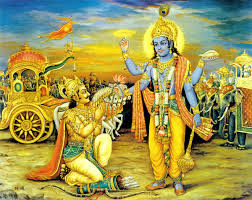Gita : Ch-7. Slo-6.
Srimad Bhagavad-Gita :
Chapter-7. ( Jnana-Vijnana-Yogam )
Slokam-6. (Of all that is material and all that is spiritual in this world, know for certain that I am both its origin and dissolution.)
etadyonini bhutani sarvanityupadharaya,
aham krtsnasya jagatah prabhavah pralayastatha.
sarvani bhutani = sarva characharm-s ( all living entities/ all creations/ everthing );
etad yonini = took birth from different prakrti-s ( natures );
iti upadharaya = know this;
aham krtsnasya jagatah = I am, of the whole jagat;
prabhavah tatha pralayah = place of origin and layanam ( of this jagat in me).
Lord Krishna is declaring that the higher and lower natures of prakriti or material nature both are constituted as His dual nature in the material existence. This dual nature consists of chit or sentient and achit insentient categories. This dual nature is the basis and foundation for all existence sentient and insentient. This dual nature is the power which designs and models according to qualifications all forms and potencies from the highest material entity, being Brahma to a blade of grass. This dual nature is the matrix for all intelligent and non-intelligent configurations and manifestations. This dual nature solely manifests from Lord Krishna and constitutes the substratum of all material things. He alone is the originator, the manifestor, the projector and the retractor of the total creation by only a fraction of His will.
This dual nature of chit and achit being the collective compound of all creation exists within the complete nature of the Supreme Lord as merely an infinitesimal fragment of the total. This is given in sruti and smrti or revealed Vedic scriptures as evidenced in the Subala Upanisad:II beginning mahan avyak ta liyate aksharam tamasi liyate which means:The mahat or primal manifestation revolves back into avyakta the unmanifest, avyakta manifests into akshara the supra subtle invariable substance, akshara devolves into tamas the primordial undifferentiated basic substratum of the original prakriti which is complete darkness. This is a homogeneous refraction of nebulosity substratum existing as a diametrical reflection of the nebula within the Supreme Being.
It is not only that all creation is dependent upon Lord Krishna but also the wonderful phenomena of creation itself is a form of His splendour. Because of His splendour there is beauty and supremacy as well due to He being the established cause, the ultimate enjoyer and the illuminator. The Vedic scriptures iterate: That Lord Krishna is the all knowing, all performing, all enjoying, all fragrance and all essence. He is all things that can be seen or thought even though unknowable in words to be described by speech. Thus is He eulogised. Creation, preservation and destruction are all co-ordinated, orchestrated, energised and illuminated solely by just a fragment of Lord Krishna. Thus have seers and sages praised Him throughout the millenniums. The Narada Purana states: Because He is the ultimate enjoyer of all, He is known as sarva or everything and not because of His universal form. Even the enjoyments of the future are always His. Therefore through His inconceivable power all enjoyments are His.
Gross manifestations and consciousness is the lower form of prakriti or the material substratum and subtle manifestations and consciousness is the higher form. Both are endowed with the attributes of three gunas or goodness, passion and ignorance; but only the subtle higher form is endowed with Sri or Laksmi Devi the beloved of the Supreme Lord. Both these forms are subservient to Lord Krishna and cause all the worlds to be created. Lord Krishna is the father of creation and from His energy Sri being the subtle consciousness can be seen as the mother of creation. Energised by Lord Krishna's creative potency all creation is manifested through her.
By describing the lower and higher, dual nature of prakriti the material substratum, Lord Krishna effectively explains His being their complete cause. All things moving and stationary have prakriti for their origin and are included in one of these two prakriti being either kshetra the field of activity and kshetrajna the utiliser of the field of activity. Of these the inert lower nature evolves as a physical body. Whereas the sentient prakriti with an eternal spark from the Supreme Lord being the atma or soul enters into all sentient beings as the witness and experiencer and sustains each and every being by their actions. Both these two prakritis are manifested from Lord Krishna and all living entities are subject to them. He is the originating cause from which each and everything effectively comes into existence. He is the ultimate cause of all creation entirely and He is also the sovereign cause of the periodic dissolution of all creation as well.
Lord Krishna now reveals that He alone is the sole source of the entire creation and its dissolution as well. Everything in all creation movable and immovable have manifested and evolved from His two fold nature. He is the cause of the creation of the inanimate temporary physical body and He is the cause of the animate eternal embodied atma or soul. The inanimate reality is due to a modification of His propensity as He becomes the substratum while the animate reality is the way by which He enters into material nature and enjoying participates and interacts with it. The physical body cannot sustain and grow without the life principle of the atma and both the physical body and the soul are both His powers and both completely under His control. The power and the powerful cannot remain separate because the source of the power is found residing in the powerful only.
To be contiued ....






Comments
Post a Comment